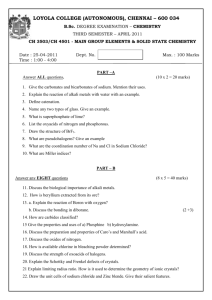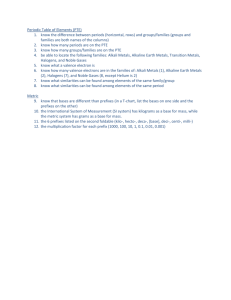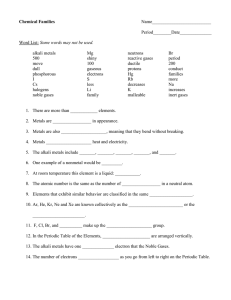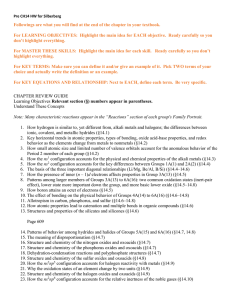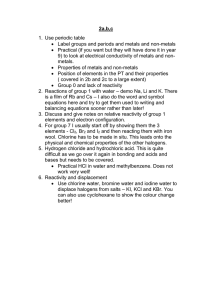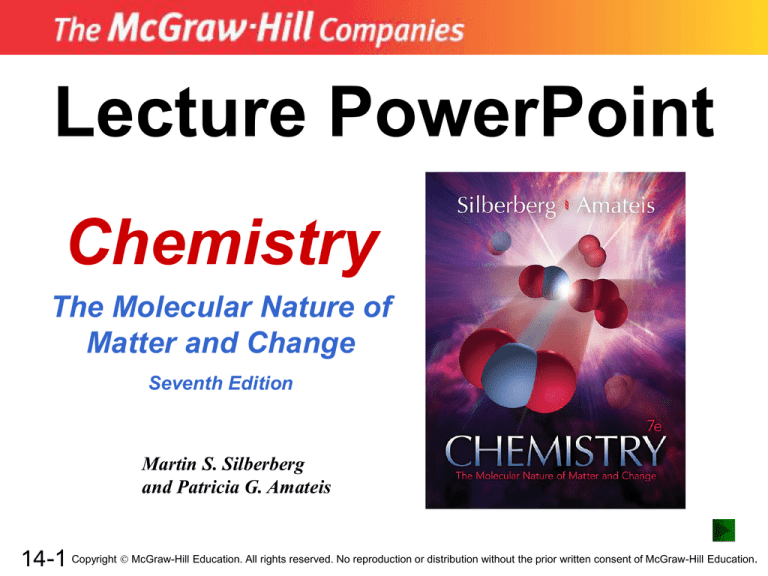
Lecture PowerPoint
Chemistry
The Molecular Nature of
Matter and Change
Seventh Edition
Martin S. Silberberg
and Patricia G. Amateis
14-1 Copyright McGraw-Hill Education. All rights reserved. No reproduction or distribution without the prior written consent of McGraw-Hill Education.
Chapter 14
Periodic Patterns in the Main-Group Elements
14-2
Periodic Patterns in the Main-Group Elements
14.1
Hydrogen, the Simplest Atom
14.2
Trends Across the Periodic Table: The Period 2 Elements
14.3
Group 1A(1): The Alkali Metals
14.4
Group 2A(2): The Alkaline Earth Metals
14.5
Group 3A(13): The Boron Family
14.6
Group 4A(14): The Carbon Family
14.7
Group 5A(15): The Nitrogen Family
14.8
Group 6A(16): The Oxygen Family
14.9
Group 7A(17): The Halogens
14.10 Group 8A(18): The Noble Gases
14-3
Hydrogen
• Hydrogen has a very simple structure:
– the nucleus has a single positive charge, and has 1 electron.
• Hydrogen is the most abundant element in the universe.
• Hydrogen exists as a diatomic gas, H2.
– H2 is colorless and odorless with very low melting and boiling
points.
• H is abundant in combination with oxygen as H2O.
14-4
Figure 14.1
14-5
Where does hydrogen belong?
Hydrogen and the Alkali Metals
• Like the Group 1A(1) elements, hydrogen
– has an outer electron configuration of ns1,
– has a single valence electron, and
– has a common +1 oxidation state.
• Unlike the alkali metals, hydrogen
– shares electrons with nonmetals rather than transferring e– to
them.
– has a much higher ionization energy than any alkali metal, due
to its small size.
14-6
Hydrogen and Group 4A
• Like the Group 4A(1) elements, H has a half-filled
valence level.
• H is similar to the other Group 4A elements in terms of
– ionization energy,
– electron affinity,
– electronegativity, and
– bond energies.
14-7
Hydrogen and the Halogens
• Like the halogens or Group 7A(17), hydrogen
– exists as a diatomic molecule and
– needs only 1 electron to fill its valence shell.
• Unlike the halogens
– H has a much lower electronegativity than any halogen,
– H lacks the three valence lone e- pairs that halogens have, and
– halide ions (X-) are common and stable, but the hydride ion (H-)
is rare and reactive.
14-8
Highlights of Hydrogen Chemistry
Ionic (saltlike) hydrides form when hydrogen reacts with
very reactive metals.
These hydrides are white, crystalline solids.
2Li(s) + H2(g) → 2LiH(s)
Ca(s) + H2(g) → CaH2(s)
Covalent (molecular) hydrides form when hydrogen reacts
with nonmetals. In most covalent hydrides, hydrogen has an
oxidation number of +1.
F2(g) + H2(g) → 2HF(g) DH°rxn = −546 kJ
14-9
Highlights of Hydrogen Chemistry
Many transition metals form metallic (interstitial) hydrides,
in which H2 molecules and H atoms occupy the holes in the
crystal structure of the metal.
Figure 14.2
14-10
A metallic (interstitial) hydride.
Trends for the Period 2 Elements
• Atomic size generally decreases across the period.
• Ionization energy and electronegativity increase across
the period.
• Metallic character decreases across the period.
– The type of bonding exhibited changes with metallic character.
• Oxides of the elements become more acidic across the
period.
• Reducing strength decreases through the metals, and
oxidizing strength increases through the nonmetals.
14-11
Table 14.1
14-12
Trends in Atomic, Physical, and Chemical Properties
of the Period 2 Elements.
Table 14.1
14-13
Trends in Atomic, Physical, and Chemical Properties
of the Period 2 Elements.
Table 14.1
14-14
Trends in Atomic, Physical, and Chemical Properties
of the Period 2 Elements.
Table 14.1
14-15
Trends in Atomic, Physical, and Chemical Properties
of the Period 2 Elements.
Table 14.1
Trends in Atomic, Physical, and Chemical Properties
of the Period 2 Elements.
Trends in atomic radius, ionization energy, and electronegativity
across Period 2.
14-16
Anomalous Behavior in Period 2
Anomalous behavior in some Period 2 elements is due to
their relatively small size and small number of valence
orbitals.
Lithium is the only element in Period 2 that forms a simple
oxide and nitride.
All beryllium compounds exhibit covalent bonding. Be2+
does not exist as a discrete ion due to its extremely high
charge density.
Boron forms a complex family of compounds with metals,
and covalent compounds with hydrogen called boranes.
14-17
Figure 14.3
14-18
Overcoming electron deficiency in beryllium chloride.
Anomalous Behavior in Period 2
Carbon bonds to itself extensively and gives rise to organic
compounds.
Nitrogen is a triple-bonded, unreactive gas and is very
different from the other Group 5A elements, which are
reactive solids.
Oxygen is the only gas in Group 6A and is much more
reactive than the other members of its group.
Fluorine is much more electronegative than the other
halogens. It reacts violently with water, and HF is a weak
acid where other hydrohalic acids are strong.
14-19
Group 1A(1): The Alkali Metals
Family Portrait
KEY ATOMIC PROPERTIES, PHYSICAL PROPERTIES, AND REACTIONS
Copyright © The McGraw-Hill Companies, Inc. Permission required for reproduction or display.
14-20
Family Portrait
GROUP 1A(1): REACTIONS
• Alkali metals are powerful reducing agents.
– They always occur in nature as +1 cations rather than as free
metals.
• Alkali metals reduce halogens to form ionic solids:
– 2E(s) + X2 → 2EX(s)
(X = F, Cl, Br, I; E is the alkali metal).
• Alkali metals react vigorously with H2O:
– 2E(s) + H2O(l) → 2E+(aq) + 2OH-(aq) + H2(g)
• Alkali metals reduce H2 to form ionic hydrides:
– 2E(s) + H2(g) → 2EH(s)
• Alkali metals reduce O2 in air, and tarnish rapidly.
14-21
Properties of the Alkali Metals
• Alkali metals are the largest elements in their respective
periods and their valence electron configuration is ns1.
– The valence e– is relatively far from the nucleus, resulting in
weak metallic bonding.
• Alkali metals are unusually soft for metals. They can be
cut easily with a knife.
• Alkali metals have lower melting and boiling points than
any other group of metals.
• Alkali metals have lower densities than most metals.
14-22
Lithium floating in oil
floating on water. Alkali
metals have low densities.
14-23
Potassium reacting with
water. Alkali metals are
very reactive.
Figure 14.4 Lattice energies of the Group 1A(1) and 2A(2) chlorides.
Lattice energy increases as the size of the cation decreases and its
charge increases.
14-24
Group 2A(2): The Alkaline Earth Metals
• The oxides of Group 2A(2) elements form basic solutions
and melt at extremely high temperatures.
• Group 2A(2) elements have higher ionization energies
than Group 1A(1) elements
– due to their higher effective nuclear charge and smaller size.
• Group 2A(2) elements are strong reducing agents.
14-25
Group 2A(2): The Alkaline Earth Metals Family Portrait
KEY ATOMIC PROPERTIES, PHYSICAL PROPERTIES, AND REACTIONS
Copyright © The McGraw-Hill Companies, Inc. Permission required for reproduction or display.
14-26
Family Portrait
GROUP 2A(2) REACTIONS
• The metals reduce O2 to form oxides:
– 2E(s) + O2(g) → 2EO(s)
• The larger metals reduce water to form H2 gas:
– E(s) + 2H2O(l) → E2+(aq) + 2OH-(aq) + H2(g) (E = Ca, Sr, Ba)
• The metals reduce halogens to form ionic halides:
– E(s) + X2 → EX2(s)
[X = F (not with Be), Cl, Br, I]
• Most of the elements reduce H2 to form ionic hydrides:
– E(s) + H2(g) → EH2 (s)
14-27
(E = all except Be)
Family Portrait
GROUP 2A(2) REACTIONS
• The elements reduce nitrogen to form ionic nitrides:
– 3E(s) + N2(g) → E3N2(s)
• Except for BeO, the element oxides are basic:
– EO(s) + H2O(l) → E2+(aq) + 2OH-(aq)
• All carbonates undergo thermal decomposition:
ECO3(s)
14-28
Δ
EO(s) + CO2(g)
Figure 14.5 Three diagonal relationships in the periodic table.
14-29
Group 3A(13): The Boron Family
Family Portrait
KEY ATOMIC PROPERTIES, PHYSICAL PROPERTIES, AND REACTIONS
Copyright © The McGraw-Hill Companies, Inc. Permission required for reproduction or display.
14-30
Family Portrait
GROUP 3A(13) REACTIONS
• The elements react sluggishly, if at all, with water:
– 2Ga(s) + 6H2O(hot) → 2Ga2+(aq) + 6OH-(aq) + 3H2(g)
– 2Tl(s) + 2H2O(steam) → 2Tl+(aq) + 2OH-(aq) + H2(g)
• When strongly heated in pure O2, all members form
oxides:
4E(s) + 3O2(g)
Δ
2E2O3(s)
(E = B, Al, Ga, In)
– Tl forms Tl2O; oxide acidity increases down the group
• All members reduce halogens (X2)
– 2E(s) + 3X2 → 2EX3
– 2Tl(s) + X2 → 2TlX(s)
14-31
(E = B, Al, Ga, In)
Influence of Transition Elements on
Group 3A(13)
Zeff increases for the larger 3A elements due to poor
shielding by d and f electrons.
The larger 3A elements have smaller atomic radii and
larger ionization energies and electronegativities than
expected.
These properties influence the physical and chemical
behavior of these elements.
14-32
Features of Group 3A(13) Elements
Larger Group 3A elements exhibit multiple oxidation
states.
They may lose either the np electron only, or both the np and ns
electrons.
The lower oxidation state becomes increasingly prominent
down the group, since the ns2 electrons form an inert pair.
Oxides of the element in the lower oxidation state are more
basic than oxides in the higher oxidation state.
In2O is more basic than In2O3.
14-33
Figure 14.6
The dimeric structure of gaseous aluminum chloride.
Compounds of 3A elements have more covalent character than
similar 2A compounds.
Aluminum has the physical properties of a metal, but its halides
exist as covalent dimers.
14-34
Highlights of Boron Chemistry
All boron compounds are covalent, and B forms a variety
of network covalent compounds with other elements.
Boron is often electron-deficient in compounds, and acts
effectively as a Lewis acid since it can accept an e- pair.
BF3(g) + :NH3(g) → F3B–NH3(g)
Boron forms bridge bonds, in which one pair of electrons
is shared between three atoms. This type of bonding is
common between B and H.
14-35
Figure 14.7
The two types of covalent bonding in diborane.
Hydride bridge bond , or three-center,
two-electron bond.
Normal covalent bond formed
by overlap of sp3 hybrid orbital
from B with s orbital from H.
14-36
Figure 14.8
The boron icosahedron and one of the boranes.
Copyright © The McGraw-Hill Companies, Inc. Permission required for reproduction or display.
14-37
Beryllium and Aluminum
• There is a diagonal relationship between Be and Al.
• Both form oxoanions in strong base:
– beryllate, Be(OH)42- and aluminate, Al(OH)4-.
• Both have bridge bonds in their hydrides and chlorides.
• Their oxides are
– coatings that are impervious to water,
– amphoteric, and
– extremely hard with high melting points.
• Some Al and all Be compounds have significant
covalent character.
14-38
Group 4A(14): The Carbon Family
Family Portrait
KEY ATOMIC PROPERTIES, PHYSICAL PROPERTIES, AND REACTIONS
Copyright © The McGraw-Hill Companies, Inc. Permission required for reproduction or display.
14-39
Family Portrait
GROUP 4A(14): REACTIONS
• The Group 4A(14) elements are oxidized by halogens:
– E(s) + 2X2 → EX4
(E = C, Si, Ge)
– The +2 halides are more stable for tin and lead, SnX2 and PbX2.
• The elements are oxidized by O2:
– E(s) + O2(g) → EO2
(E = C, Si, Ge, Sn)
– Pb forms the +2 oxide, PbO.
• Oxides become more basic down the group.
• Hydrocarbons react with O2:
– CH4(g) + 2O2(g) → CO2(g) + 2H2O(g)
• Silica is reduced to form elemental silicon:
– SiO2(s) + 2C(s) → Si(s) + 2CO(g)
14-40
Table 14.2
14-41
Bond Type and the Melting Process in
Groups 3A(13) to 5A(15)
Allotropes
Allotropes are different crystalline or molecular forms of
the same element.
One allotrope of a particular element is usually more stable than
another at a particular temperature and pressure.
Carbon has several allotropes, including graphite,
diamond, and fullerenes.
Tin exhibits two allotropes; white β-tin and gray α-tin.
14-42
Figure 14.9
14-43
Phase diagram of carbon.
Figure 14.10 Crystalline buckminsterfullerene and a buckyball (A)
and nanotubes (B).
14-44
Bonding in Group 4A(14) Compounds
Carbon forms predominantly covalent bonds, but the
larger members of the group form bonds with
increasing ionic character.
Elements of this group also exhibit multiple oxidation
states. Lower oxidation states become more
prominent down the group.
Pb and Sn show more metallic character in their lower
oxidation states.
SnCl2 and PbCl2 are white, crystalline solids with high melting
points. SnCl4 is a volatile, benzene-soluble liquid.
14-45
Figure 14.11 Salt-like +2 chlorides and oily +4 chlorides show
greater metallic character of tin and lead in the
lower oxidation state.
Copyright © The McGraw-Hill Companies, Inc. Permission required for reproduction or display.
14-46
Carbon in Organic Chemistry
The large number and wide variety of organic compounds
is due to the ability of C to bond to itself, and to form
multiple bonds.
Catenation is the process whereby carbon bonds to itself
to form stable chains, branches, and rings.
Since C is small, the C-C bond is short enough to allow
effective side-to-side overlap of p orbitals. C readily forms
double and triple bonds.
14-47
Figure 14.12 Three of the several million known organic
compounds of carbon.
14-48
Inorganic Compounds of Carbon
Carbon bonds with oxygen to form carbonates. Metal
carbonates such as CaCO3 are abundant in minerals.
Carbon forms two common gaseous oxides, CO and CO2,
which are molecular. Other Group 4A(14) elements form
network-covalent or ionic oxides.
Carbon halides have major uses as solvents and in
structural plastics.
14-49
Figure 14.13 Freon-12 (CCl2F2), a chlorofluorocarbon.
14-50
Highlights of Silicon Chemistry
Silicon bonds to oxygen to form repeating –Si–O–
units, which are found in silicates and silicones.
The silicate building unit is the orthosilicate grouping,
–SiO4 –, which has a tetrahedral arrangement.
Silicate minerals are the dominant form of matter in the nonliving
world. They include clay, sand, and semiprecious stones.
Silicone polymers are synthetic substances consisting
of alternating Si and O atoms. They are used in a wide
variety of applications.
14-51
Figure 14.14 Structures of the silicate anions in some minerals.
14-52
Figure 14.15 Quartz is a three-dimensional framework silicate.
Copyright © The McGraw-Hill Companies, Inc. Permission required for reproduction or display.
14-53
Group 5A(15) Elements
• Nitrogen is a diatomic gas (N2) with a very low boiling
point, due to its very weak intermolecular forces.
• Phosphorus exists most commonly as tetrahedral P4
molecules. It has stronger dispersion forces than N2.
• Arsenic exists as extended sheets of As atoms
covalently bonded together. The covalent network
structure gives it a high melting point.
• Antimony also has a covalent network structure.
• Bismuth has metallic bonding. Its melting point is lower
than that of As or Sb.
14-54
Group 5A(15): The Nitrogen Family
Family Portrait
KEY ATOMIC PROPERTIES, PHYSICAL PROPERTIES, AND REACTIONS
Copyright © The McGraw-Hill Companies, Inc. Permission required for reproduction or display.
14-55
Family Portrait
GROUP 5A(15) REACTIONS
• Nitrogen is “fixed” industrially in the Haber process:
– N2(g) + 3H2(g) D 2NH3(g)
• Hydrides of other group members are formed by reaction
in water or acid of a metal phosphide, arsenide, etc.
– Ca3P2(s) + 6H2O(l) → 2PH3(g) + 3Ca(OH)2(aq)
• Halides are formed by direct combination of the
elements:
– 2E(s) + 3X2 → 2EX3
(E = all except N)
– EX3 + X2 → EX5 (E = all except Ni and Bi with X = F and Cl, but
not BiCl5; E = P for X = Br)
14-56
Family Portrait
GROUP 5A(15) REACTIONS
• Oxoacids are formed from the halides in a reaction with
water:
– EX3 + 3H2O(l) → H3EO3(aq) + 3HX(aq)
– EX5 + 4H2O(l) → H3EO4(aq) + 5HX(aq)
(E = all except N)
(E = all except N and Bi)
Note that the oxidation number of E does not change.
14-57
Figure 14.16
Two allotropes of phosphorous.
Copyright © The McGraw-Hill Companies, Inc. Permission required for reproduction or display.
Strained bonds in P4
White phosphorous (P4)
Red phosphorous
14-58
Patterns of Behavior in Group 5A(15)
• N gains 3 electrons to form the anion N3-, but only in
compounds with active metals.
• The higher elements in the group are metallic and lose
electrons to form cations.
• Oxides change from acidic to amphoteric to basic as you
move down the group.
• All Group 5A(15) elements form gaseous hydrides with
the formula EH3.
– All except NH3 are extremely reactive and toxic.
14-59
Oxides of Nitrogen
• Nitrogen forms six stable oxides. DHf for all six oxides is
positive because of the great strength of the NΞN bond.
• NO is produced by the oxidation of ammonia:
– 4NH3(g) + 5O2(g) → 4NO(g) +6H2O(g)
– This is the first step in the production of nitric acid.
• NO is converted to 2 other oxides by heating:
3NO(g)
Δ
N2O(g) + NO2(g)
– This type of redox reaction is called disproportionation.
• NO2 is a component of photochemical smog.
14-60
Table 14.3
14-61
Structures and Properties of the Nitrogen Oxides
Nitrogen Oxoacids and Oxoanions
• Nitric acid (HNO3) is produced by the Ostwald process:
– The third step is 3NO2(g) + H2O (l) → 2HNO3 + NO(g)
• Nitric acid is a strong oxidizing agent as well as a strong
acid.
• The nitrate (NO3-) also acts as an oxidizing agent.
– All nitrate salts are water soluble.
• Nitrous acid (HNO2) is a much weaker acid than nitric
acid.
– This follows the general pattern for oxoacids – the more O atoms
bonded to the central nonmetal, the stronger the acid.
14-62
Figure 14.17 The structures of nitric and nitrous acids and their
oxoanions.
Copyright © The McGraw-Hill Companies, Inc. Permission required for reproduction or display.
14-63
Figure 14.18
Important oxides of phosphorous.
Copyright © The McGraw-Hill Companies, Inc. Permission required for reproduction or display.
P4O6 has P in its +3 oxidation state.
P4O10 has P in its +5 oxidation state.
This compound is a powerful drying agent.
14-64
Oxoacids of Phosphorus
H3PO3 has only two acidic H atoms; the third is bonded to the
central P and does not dissociate.
H3PO4 has three acidic H atoms. It is a weak acid, but in strong
base all three H+ are lost to give the phosphate anion.
14-65
Figure 14.19
The diphosphate ion and polyphosphates.
Copyright © The McGraw-Hill Companies, Inc. Permission required for reproduction or display.
Hydrogen phosphates lose water when heated to give
polyphosphates, which contain P–O–P linkages.
14-66
Group 6A(16) Elements
• Oxygen, like nitrogen, occurs as a low-boiling diatomic
gas, O2.
• Sulfur, like phosphorus, occurs as a polyatomic
molecular solid.
• Selenium, like arsenic, commonly occurs as a gray
metalloid.
• Tellurium, like antimony, displays network covalent
bonding.
• Polonium, like bismuth, has a metallic crystal structure.
14-67
Group 6A(16): The Oxygen Family
Family Portrait
KEY ATOMIC PROPERTIES, PHYSICAL PROPERTIES, AND REACTIONS
Copyright © The McGraw-Hill Companies, Inc. Permission required for reproduction or display.
14-68
Family Portrait
GROUP 6A(16) REACTIONS
• Halides are formed by direct combination:
– E(s) + X2(g) → various halides
(E = S, Se, Te; X = F, Cl)
• The other elements in the group are oxidized by O2:
– E(s) + O2(g) → EO2
(E = S, Se, Te, Po)
• SO2 is oxidized further:
– 2SO2(g) + O2(g) → 2SO3(g)
• The thiosulfate ion is formed when an alkali metal sulfite
reacts with sulfur:
– S8(g) + 8Na2SO3(s) → 8Na2S2O3(aq)
14-69
Allotropes in the Oxygen Family
Oxygen has two allotropes:
- O2, which is essential to life, and
- O3 or ozone, which is poisonous.
Sulfur has more than 10 different forms, due to the ability
of S to catenate. S–S bond lengths and bond angles may
vary greatly.
Selenium has several allotropes, some consisting of
crown-shaped Se8 molecules.
14-70
Figure 14.20
The cyclo-S8 molecule.
Copyright © The McGraw-Hill Companies, Inc. Permission required for reproduction or display.
top view
side view
At room temperature, the sulfur molecule is a crown-shaped ring of
eight atoms. The most stable S allotrope is orthorhombic α-S8,
which consists of cyclo-S8.
14-71
Hydrides of the Oxygen Family
• Oxygen forms two hydrides:
– water (H2O) and hydrogen peroxide (H2O2).
– H2O2 contains oxygen in a -1 oxidation state.
• The hydrides of the other 6A elements are foul-smelling,
poisonous gases.
– H2S forms naturally in swamps from the breakdown of organic
matter and is as toxic as HCN.
• H2O and H2O2 can both form H bonds, and therefore
have higher melting and boiling points than other H2E
compounds.
• Hydride bond angles decrease and bond lengths
increase down the group.
14-72
Halides of the Oxygen Family
Except for O, the Group 6A elements form a wide range of
halides.
Their structure and reactivity patterns depend on the sizes of the
central atom and the surrounding halogens.
As the central atom becomes larger, the halides become
more stable.
This pattern is related to the effect of electron repulsions
due to crowding of lone pairs and halogen atoms around
the central atom.
This is opposite to the previously observed bonding patterns, where
bond strength decreases as bond length increases.
14-73
Highlights of Sulfur Chemistry
• Sulfur forms two important oxides:
– SO2 has S in its +4 oxidation state. It is a colorless, choking gas
that forms when S, H2S, or a metal sulfide burns in air.
– SO3 has S in the +6 oxidation state.
• Sulfur forms two important oxoacids:
– Sulfurous acid (H2SO3) is a weak acid with two acidic protons.
– Sulfuric acid (H2SO4) is a strong acid, and is an important
industrial chemical. It is an excellent dehydrating agent.
14-74
Figure 14.21 The dehydration of sugar by sulfuric acid.
14-75
Group 7A(17): The Halogens
Family Portrait
KEY ATOMIC PROPERTIES, PHYSICAL PROPERTIES, AND REACTIONS
Copyright © The McGraw-Hill Companies, Inc. Permission required for reproduction or display.
14-76
Family Portrait
GROUP 7A(17) REACTIONS
• The halogens (X2) oxidize many metals and nonmetals.
The reaction with H2 is characteristic:
– X2 + H2(g) → 2HX(g)
• The halogens undergo disproportionation in water:
– X2 + H2O(l) D HX(aq) + HXO(aq) (X = Cl, Br, I)
• In aqueous base, the reaction goes to completion to form
hypohalites and, at higher temperatures, halates:
3Cl2(g) + 6OH-(aq)
14-77
Δ
ClO3-(aq) + 5Cl-(aq) + 3H2O(l)
Reactivity of the Halogens
A halogen atom needs only one electron to fill its valence
shell. Halogens are therefore very reactive elements.
The halogens display a wide range of electronegativities, but
all are electronegative enough to behave as nonmetals.
A halogen will either
- gain one electron to form a halide anion or
- share an electron pair with a nonmetal atom.
The reactivity of the halogens decreases down the group,
reflecting the decrease in electronegativity.
14-78
Figure 14.22
Bond energies and bond lengths of the halogens.
Copyright © The McGraw-Hill Companies, Inc. Permission required for reproduction or display.
F2 shows an anomalous bond energy. The F-F bond is weaker
than expected since the lone pairs on the small F atom repel each
other more than the lone pairs of other halogens.
F2 is the most and I2 the least reactive halogen.
14-79
Figure 14.23
The relative oxidizing ability of the halogens.
Copyright © The McGraw-Hill Companies, Inc. Permission required for reproduction or display.
Halogens are strong oxidizing agents. The oxidizing ability of X2
decreases down the group while the reducing ability of X- increases.
14-80
Figure 14.23 continued
Cl2(aq) + 2I-(aq) → 2Cl-(aq) + I2 (in CCl4)
Cl2 is a stronger oxidizing agent than I2. Cl2 will therefore displace
I- from solution. I2 will not displace Cl- ions.
14-81
Interhalogen Compounds
Halogens bond with each other to form interhalogen
compounds.
The central atom will have the lower electronegativity and a positive
oxidation state.
The interhalogens illustrate a general principle of oxidation
states: odd-numbered groups exhibit odd-numbered
oxidation states while even-numbered groups exhibit evennumbered oxidation states.
When bonds form or break, two electrons are involved, so the oxidation
states of the atoms involved commonly change by 2.
14-82
Odd-numbered oxidation states:
F and I are both in Group 7A, an odd-numbered group.
0
+1
+1
IF + F2 → IF3
I2 + F2 → 2IF
0
+3
-1
-1
0
-1
Even-numbered oxidation states:
S is in Group 6A, an even-numbered group.
0
+2
S + F2 → SF2
14-83
+2
+4
SF2 + F2 → SF4
Figure 14.24 Molecular shapes of the main types of interhalogen
compounds.
Copyright © The McGraw-Hill Companies, Inc. Permission required for reproduction or display.
ClF
ClF3
linear, XY
BrF5
IF7
Square
pyramidal, XY5
14-84
T-shaped, XY3
Pentagonal
bipyramidal, XY7
Figure 14.25
Chlorine oxides.
Copyright © The McGraw-Hill Companies, Inc. Permission required for reproduction or display.
lone eDichlorine monoxide
Cl2O
Dichlorine heptaoxide
Cl2O7
Chlorine dioxide
ClO2
14-85
Table 14.4
14-86
The Known Halogen Oxoacids*
Relative Strength of Halogen Oxoacids
The relative strength of halogen oxoacids depends on
both the electronegativity and the oxidation state of
the halogen.
For oxoacids with the halogen in the same oxidation state,
acid strength decreases as the halogen EN decreases.
HOClO2 > HOBrO2 > HOIO2
For oxoacids of a given halogen, acid strength decreases
as the oxidation state of the halogen decreases.
HOClO3 > HOClO2 > HOClO
14-87
Group 8A(18): The Noble Gases
Family Portrait
KEY ATOMIC PROPERTIES, PHYSICAL PROPERTIES, AND REACTIONS
Copyright © The McGraw-Hill Companies, Inc. Permission required for reproduction or display.
14-88
Noble Gases
• Noble gases have a full valence shell.
• The noble gases are the smallest elements in their
respective periods, with the highest ionization energies.
• Atomic size increases down the group and IE decreases.
• Noble gases have very low melting and boiling points.
• Only Kr, Xe, and Rn are known to form compounds.
– Xe is the most reactive noble gas and exhibits all even oxidation
states from +2 to +8.
14-89
Figure 14.26
Crystals of xenon tetrafluoride (Xe(F4).
Copyright © The McGraw-Hill Companies, Inc. Permission required for reproduction or display.
14-90

